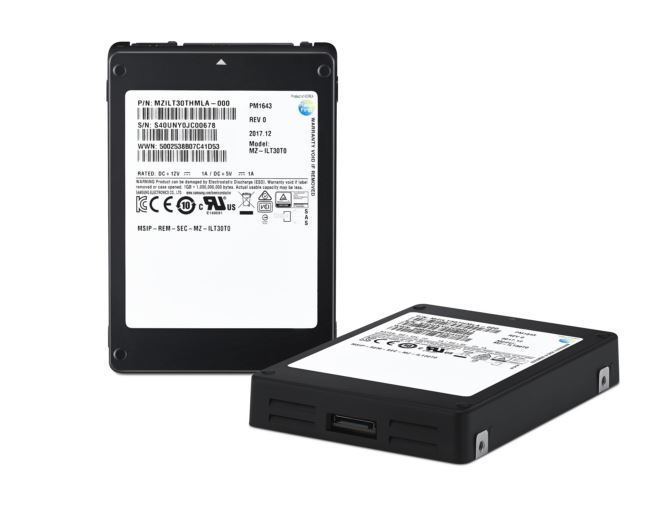Samsung Releases 'Industry's Largest' SAS SSD At 30.72TB
Samsung announced today that it is mass producing a 30.72TB SSD, which it claims is the industry's largest. The company originally announced this new enterprise SSD in August 2016.
Above is our picture of Samsung's floating SSD case back when it announced the beefy slab of flash. As you can see, the company originally marketed the PM1643 SSD as a 32TB model but has since revised the total capacity, likely to accommodate overprovisioning. The PM1643 comes on the heels of Samsung's PM1633a, which weighed in at 15.63TB. It previously held the crown as the biggest SAS SSD on the market.
Samsung claims the PM1643 reaches 2,100/1,700 MB/s of sequential read/write throughput and up to 400,000/50,000 read/write IOPS. That's impressive random read performance, but random writes are somewhat slower than some competing SSDs. We do expect that kind of performance reduction in exchange for extra capacity, but it will be interesting to examine the performance specifications on the smaller models when Samsung releases more detailed data. The company plans to add 15.36, 7.68, 3.82, and 1.92TB options. It also has 960 and 800GB models planned.
Samsung's new 30.72TB whopper uses a 12Gb/s SAS connection that provides the dual port and failover features prized in the data center. New NVMe SSDs have similar features via the latest versions of the specification, but we have yet to see such voluminous capacities in the performance-focused NVMe realm. Like its other capacious counterparts, the drive comes in a 2.5" form factor with a 15mm thickness, which means it will not fit in your laptop.
As with any fast SSD, the PM1643 comes with plenty of DRAM to help speed up internal operations. The PM1643 wields 40GB of DRAM that is grouped into 4GB packages using TSV (Through-Silicon Vias), which marks the first time TSV DRAM has made its way into an SSD.
Samsung uses 32 1TB flash packages inside the SSD, with each consisting of a stack of 16 512Gb 3D NAND die. Managing all the DRAM and flash with a single controller is nearly impossible within the required thermal envelope of a 2.5" device, so Samsung spread the task out among nine different controllers. This type of distributed architecture is common in high-capacity SAS SSDs, such as Seagate's SAS SSDs that use eASIC bridges. Samsung uses its own controllers, so it is likely a custom implementation.
Samsung rates the drive for 1 DWPD (Drive Write Per Day) of endurance, so you can write 30.72TB of data every day for the five-year warranty period. It also comes with the enterprise-class features we expect from this type of drive, such as robust error correction and power loss protection.
Get Tom's Hardware's best news and in-depth reviews, straight to your inbox.
Samsung is actively selling the drives, but it has not listed pricing. These drives are destined for OEM systems, so pricing likely hinges on volume purchasing agreements. For us, that means it falls into the "if you have to ask" category.

Paul Alcorn is the Editor-in-Chief for Tom's Hardware US. He also writes news and reviews on CPUs, storage, and enterprise hardware.
-
Giroro So 1 drive write per day for 5 years = 1825 writes per each cell in flash... but that number also most likely includes 2 TB of extra cells for over-provisioning (or maybe not actually). I wouldn't be surprised if far less than 27TiB of this thing actually end up usable.Reply
Regardless, that is really bad longevity. Even the worst TLC NAND should be able to reach at least 3,000 writes. Is this QLC or something?
Something about this combined with other moves from Samsung in the enterprise market seems rushed and desperate. I think Samsung is realizing their NAND can't come close to competing with the 3D-Xpoint in Optane. -
adgjlsfhk I think the reason it is only rated for 1dwpd is that if you take it's 1.7GB/s write speed, if all you are doing is writing to it continuously, you can only write 146TB per day (4.8 dwpd). This endurance rating probably came from not wanting to spend the 3+ years of testing it would take to actually confirm that it could write for more than that. Also, any reasonable use of these will probably be reading about as much as it is writing so 1dwpd basically just means it shouldn't be under full write load 24/7Reply -
therealduckofdeath Yeah, since it's Enterprise they're putting a lot of margin on the recommendations. Enterprise customers tends to get grumpy if things they buy doesn't work as expected.Reply

